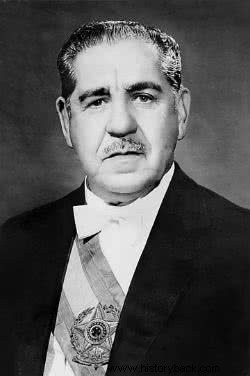Costa e Silva was a military man, politician and the 27th President of the Republic of Brazil . He held the position between 1967 and 1969.
Biography

Artur da Costa e Silva was born on October 3, 1899 in the city of Taquari, Rio Grande do Sul. He was the son of Aleixo Rocha da Silva and Almerinda Mesquita da Costa e Silva.
His military education began at the Colégio Militar de Porto Alegre. After that, he joined the Escola Militar de Realengo, in Rio de Janeiro. A diligent student, he was an aspirant, lieutenant, general and marshal of the Brazilian army.
In 1922, Artur participated in the tenentista movement, at which time he was arrested. Furthermore, he participated in the Constitutionalist Revolution of 1932 in São Paulo.
In the early 1940s, Costa went to work in the United States. In the 1950s, he spent two years in Argentina as a member of the army at the Brazilian embassy.
During the government of Castello Branco, Costa e Silva was appointed Minister of War of Brazil between April 4, 1964 and June 30, 1966. In 1964, he also held the position of Minister of Mines and Energy of Brazil, for just under 1 month.
At that time, he was responsible for articulating the Military Coup of 64 alongside President Castello Branco. The coup deposed President João Goulart.
Death
Costa e Silva suffered a stroke in August 1969, which removed him from the post of president
He died in Rio de Janeiro on December 17, 1969, aged 70.
Government of Costa e Silva
Costa e Silva was President of the country for about 2 years. He was elected in 1966 and held the position from March 15, 1967 to August 31, 1969.
During that time, his tenure became known as the “years of lead” as it represented one of the toughest periods of the military dictatorship. His government was marked by strong political unrest, acts of torture, arrests and deaths.
In 1968, Institutional Act No. 5 (AI-5) was enacted, granting greater powers to the President. Marked by strong repression, this was considered one of the most difficult phases of the dictatorship in the country.
With AI-5, the National Congress, legislative assemblies and municipal councils were closed. In addition, legislative, executive, federal, state and municipal mandates were revoked.
Various types of torture were carried out against the military and civilians who were against the government.
During his government, Costa e Silva fought inflation and expanded foreign economic relations. He focused on administrative reform, expanded communications and transportation.
It was also during his government that the opposition movement called “Frente Ampla” was extinguished. It was created in 1966 and led by Carlos Lacerda and supported by Juscelino Kubitschek and João Goulart.
The “Broad Front” proposed the redemocratization of the country, direct elections for President and the creation of a new Constitution.
From 1968 onwards, a strong political agitation on the part of the students marked the “one hundred thousand march” in Rio de Janeiro.
The main cause was the death of high school student Edson Luís de Lima Souto by a military man, in addition to lack of funds and the privatization of education.
In 1969, Costa e Silva was removed from office due to health problems, being replaced by a Military Junta.
Did you know?
The Minhocão expressway in São Paulo was named “Elevado Presidente Costa e Silva”. From 2016 its name changed to “Elevado Presidente João Goulart”.
Also read about the Military Dictatorship in Brazil.
